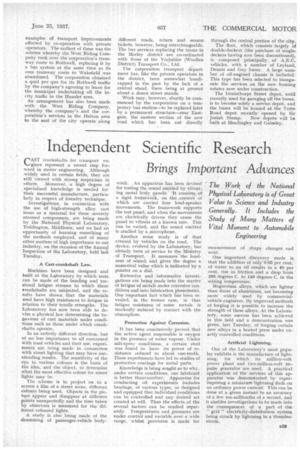Independent Scientific Research
Page 43

If you've noticed an error in this article please click here to report it so we can fix it.
Brings Important Advances
CAST crankshafts for transport engines represent a recent step forward in motor engineering. Although widely used in certain fields, they are still viewed with strong scepticism in others. Moreover, a high degree of
• specialized knowledge is needed for their successful manufacture, particularly in respect of foundry technique.
Investigations, in connection with the use of high-strength alloy cast irons as a material for these severely stressed components, are being made by the National Physical Laboratory, Teddington, Middlesex, and we had an opportunity of learning something of the methods employed, and of many other matters of high importance to our • industry, on the occasion of the Annual Inspection of the Laboratory, held last Tuesday.
A Cast-crankshaft Law.
Machines have been designed and built at the Laboratory by which -tests can be made of the bending and torsional fatigue stresses to which these crankshafts are subjected, and the results have shown that the materials used have high resistances to fatigue in relation to their tensile strengths. The Laboratory has now been able to devise a physical law determining the benaviour of cast materials under conditions such as those under which crankshafts operate. In an entirely different direction, but of no less importance to all concerned With road vehicles and their use, experiments are being made in connection with street lighting that may have outstanding results. The sensitivity of the eye to various colours is the basis of the idea, and the object, to determine What the most effective colour for street lights may be.
The scheme is to project on to a screen a film of a street scene, different Colours being used. Objects in the picture appear and disappear at different points unexpectedly and the time taken by observers is measured for the different coloured lights.
A study is also being made of the drumming of passenger-vehicle body
work. An apparatus has been devised for testing the sound emitted by vibrating metal body panels. It consists of a rigid framework, on the ,corners of which are carried four loud-speaker movements. The framework supports the test panel, and when the movements are, electrically driven they cause the panel to vibrate at a known rate. This can be varied, and the sound emitted is studied by a microphone.
Another noise study is of that created by vehicles on the road. The device, evolved by the Laboratory, has already been of service to the Ministry of Transport. It measures-Abe loudness of sound, and gives the degree a numerical value which is indicated by a pointer on a dial.
Extensive and informative investigations ate being made into the matter of fatigue of metals under corrOsive con.. ditions and into lubrication phenomena. One important fact which has been revealed, in the former case, is that fatigue resistance of some metals is markedly reduced by contact with the atmosphere.
Protection Against orrosion.
It has been conclusively proved that the active agent responsible is oxygen in the presence of water vapour. Under salt-spray conditions, a certain steel was found to have its power of resistance reduced to about one-tenth. These experiments have led to studies of protective -coatings for metal parts. •
Knowledge is being sought as to why, under certain conditions, one lubricant is better than another. Apparatus for conducting oil experiments includes bearings, of various types, so designed and equipped that individual conditions can be controlled and any desired set created at will. Thus the effects of the several factors can be studied separately. Temperatures and pressures are under control and variable over a wide range, whilst provision is made for
measurement of shape changes and wear.
One important discovery made is that the addition of only 0.05 per cent: of water to an oil results in a 40 per cent, rise in friction. and a drop from 200 degrees C. to 140 degrees C. in the seizing temperature. '
Magnesium alloys, which are lighter than those of aluminium, are becoming more widely used by commercialvehicle engineers. By improved methods of forging it is possible to increase the strength of these alloys. At the Laboratoty, some success has been achieved in this field and a demonstration was given, last Tuesday, of forging certain new alloys in a heated press under exactly controlled conditions.
Artificial Lightning.
One of the Laboratory's most popular exhibits is the manufacture of lightning, for which its million-volt power plant and two-million-volt impulse generator are used. A practical application of the services of this apparatuS was demonstrated by 'superimposing a miniature lightning flash on an ordinary power current. This can be done at a given instant 'to an accuracy of a few ten-millionths of a second, and it enables inveStigations to be made into the consequences: of a • part of the • " grid" electricity-distribution system being struck by lightning in a thunders storm.




























































































